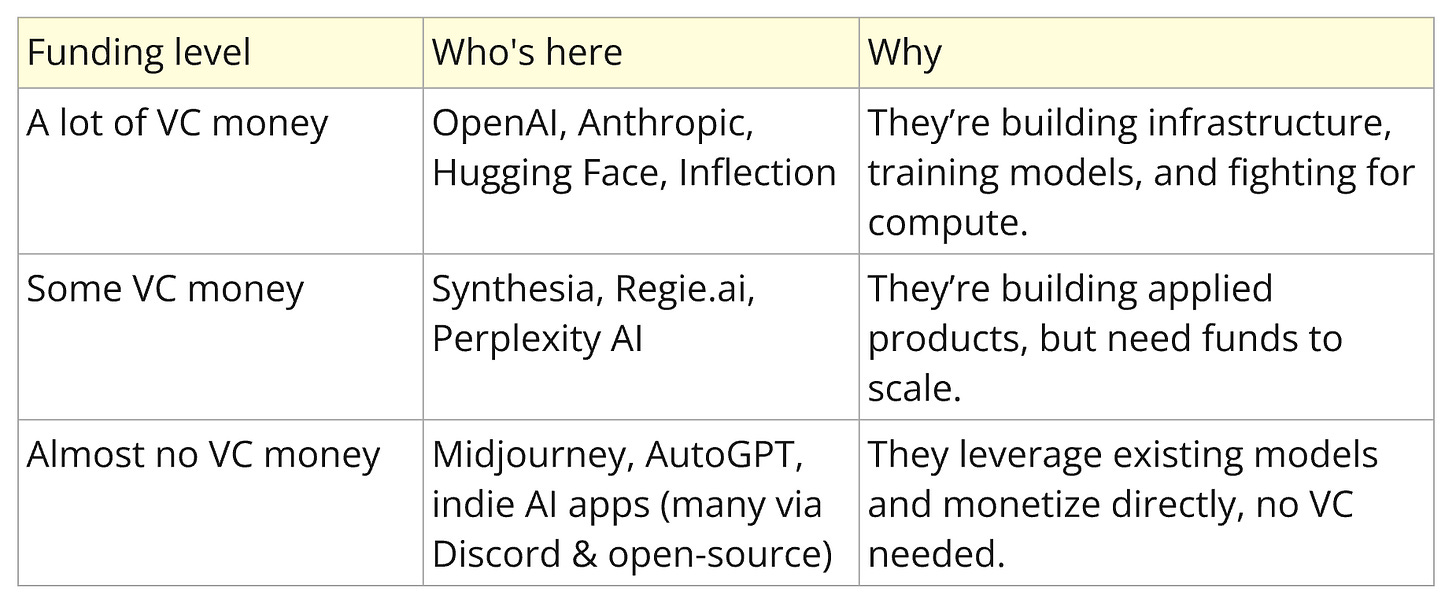The new AI Startup Playbook
I’ll admit it, I nearly choked on my ham and cheese sandwich when a VC (Paula) casually mentioned this in one of their discussion-rants: “You know, a lot of AI startups today just… don’t need that much money.”
Excuse me? The field synonymous with billion-dollar compute bills, GPU shortages, and teams of PhDs burning through term sheets like confetti?
But then I started digging, and the data told a different story. One that’s less about Silicon Valley’s old obsession with raising giant war chests, and more about a quiet revolution unfolding in the way AI-native products are built. It’s not just about how much money they raise. It’s about how few people they need and how the very nature of building AI products has rewritten the rules of startup funding.
The old AI playbook: bigger teams = bigger checks
The first wave of AI-native companies, think OpenAI, Anthropic, even Hugging Face - followed the old script. Cutting-edge AI demanded cutting-edge resources: bespoke models, mountains of training data, and the kind of compute bill that makes CFOs break into a cold sweat.
OpenAI’s famous 10 billion Microsoft deal wasn’t just about monies. It was access to Azure’s massive compute backbone. Anthropic raised over a billion to train safer models. Hugging Face secured 235 million because becoming the GitHub of machine learning isn’t cheap. These companies are building infrastructure, not just products. They’re the equivalent of building an airline - you need planes, routes, and regulators before you sell a single ticket.
In this world, VC was oxygen. No funding, no chance.
The quiet shift: AI-native, leaner, faster
But here’s where the plot twist comes in. Starting around 2022, a new class of AI-native startups emerged. Ones that didn’t need to build foundational models, but instead used them.
These companies weren’t training GPT-4 rivals. They were building apps on top of GPT-4. They weren’t inventing new computer vision algorithms, they were using pre-trained ones to build vertical tools for radiologists, real estate agents, and recruiters.
The result? Startups could get to market with a handful of engineers, a couple hundred thousand dollars (or less), and no need for a big Series A.
Suddenly, a two-person team could stitch together OpenAI’s API, a lightweight front-end, and Stripe billing. And they went live. Some even made millions in revenue before raising a cent.
The 40-person unicorn
Look no further than Midjourney, the generative AI art platform that has become the stuff of legend. With a team of just 40 people, Midjourney pulled in over 200 million in revenue - all without a single dollar of VC money.
That’s not a fluke.
Character.AI, the viral chatbot platform, hit a 1 billion valuation with a team of only 22 people. Perplexity AI, which raised far more modestly, built a search engine product with an even smaller crew.
These aren’t rounding errors. These are a blueprint for a new type of AI-native product company, one where the AI does the heavy lifting, the infrastructure is rented not built, and the team stays shockingly small.
A new kind of startup math
Here’s why this matters:
Smaller teams = smaller burn. When the product itself is a self-learning, self-operating system, you don’t need armies of customer support reps or massive dev teams. The AI handles it.
Pre-trained models = cheaper R&D. Companies used to raise millions to develop bespoke models. Now they can plug into OpenAI, Anthropic, or Mistral and spend almost nothing on core AI.
Faster to revenue = less need for runway. When you can launch in months, not years, you don’t need to raise for survival.
Does this mean VCs are out of a job?
Not exactly, but it’s changing their role. In 2022, AI funding dipped slightly. By 2023, it rebounded but the money increasingly flowed to fewer companies. In 2024, over one-third of all VC funding went to AI, but a huge chunk of that went to the OpenAIs and Anthropics of the world, not the scrappy teams stitching together existing tools.
VCs haven’t stopped funding AI but they’re more selective. They’re looking for either:
The next big infrastructure bet, the next Mistral, Aleph Alpha, or CoreWeave building the hardware or foundation models themselves. These companies need VC.
Highly efficient vertical apps, AI-native SaaS solving specific business problems (like Synthesia’s AI video generator or Regie.ai for sales outreach), where small teams show traction quickly.
Bootstrapping becomes an option, even in AI
Here’s the real shocker: AI-native companies are increasingly choosing not to raise VC at all. At least not at the start.
Why? Because they can.
In the old days, building a software product without funding meant cutting corners on quality, features, or growth. In AI, automation becomes your workforce. Customer support? More and more AI agents can handle it. Onboarding? An AI tutor can teach users. Sales outreach? AI assistants can personalize your every email.
This doesn’t just reduce costs, it shifts the whole calculus of startup funding.
You can now launch an AI SaaS, start generating revenue, and hit 1 million ARR with under 10 people. That means you can either raise less, or delay raising until you have leverage.
The new funding spectrum
Across the 2022–2024 wave of AI startups, you can see three clear funding patterns emerge:
So, so, so, do AI startups need VC anymore?
Here’s the uncomfortable truth: it depends what kind of AI company you are.
If you’re chasing frontier research - VC is still your lifeline.
If you’re building apps on top of foundation models - you might not need VC at all, especially if you find early customers.
If you’re somewhere in between - a smart, lean raise (a “right-sized Series A”) might be enough to get you profitable.
What’s clear is that the days of blindly raising huge rounds to chase AI hype are over. Investors want to see:
✅ Evidence you can get to revenue fast.
✅ A lean team that doesn’t need to scale headcount 10x.
✅ Smart use of existing AI infrastructure, not reinvention.
The bottom line
AI-native startups aren’t just automating industries - they’re automating themselves.
The smartest founders are asking a radical question:
What if the AI isn’t just the product - what if it’s also the team?
The answer, for a growing number of them, is a future with fewer employees, smaller funding rounds, and faster paths to profit than anyone thought possible.
The old startup playbook was: raise early, raise often, hire fast.
The new AI-native playbook? Raise later, raise less, hire slow - lean on AI.



